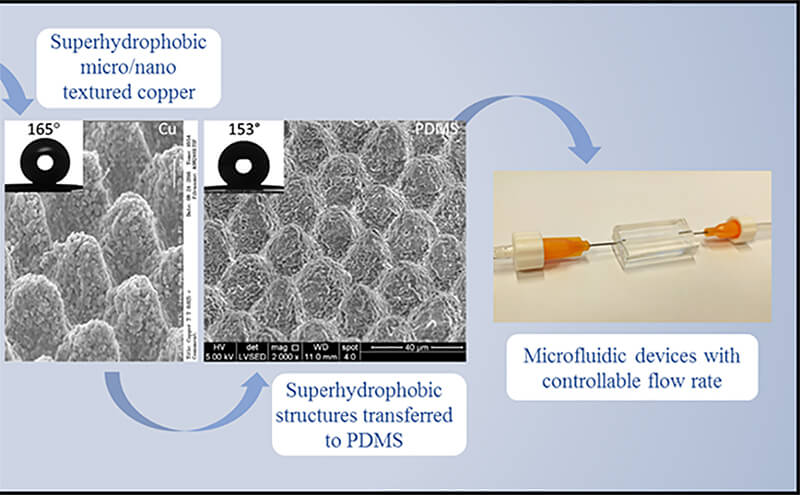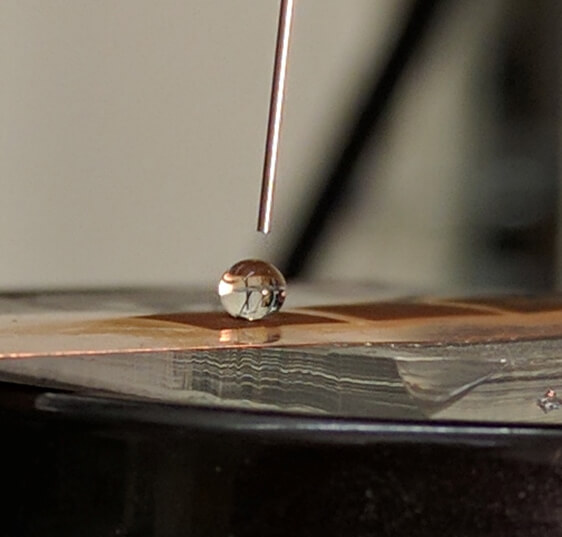June 27, 2018
New manufacturing process creates super-small channels to repel water and improve medical, electronic devices

This image shows the creation of a superhydrophobic surface on a metal surface by an ultrafast laser, which is transferred to PMDS via transfer molding and assembled into a microfluidic device. (Image provided)
WEST LAFAYETTE, Ind. – A new manufacturing process developed by Purdue University researchers may improve the water repellency for some common products, ranging from medical equipment and sensors to vehicle engines and windshields.
The Purdue team, led by Yung Shin, the Donald A. and Nancy G. Roach Professor of Advanced Manufacturing in the Purdue School of Mechanical Engineering, developed a new method to create superhydrophobic microchannels on polymers. This technology provides a quick and inexpensive fabrication technique to create microfluidic devices having channels with controllable flow rates, without the use of chemical treatments or complex flow-control devices.
“These are basically small channels that are made in such a way that water cannot stick to the surface or give little resistance in the flow,” Shin said. “You can then send water or other liquids through and create smaller cooling channels and microfluidic devices.”
Shin’s team uses a two-step process to create the superhydrophobic surfaces. First, they create patterns or features on a metal surface with an ultra-fast laser. Then, in a process called transfer molding, the researchers create that same pattern on the polymer.
 This image shows a water drop on a created superhydrophobic surface, showing a very high contact angle. Purdue University researchers developed a new manufacturing process to improve the water repellency for some common products. (Image provided)
This image shows a water drop on a created superhydrophobic surface, showing a very high contact angle. Purdue University researchers developed a new manufacturing process to improve the water repellency for some common products. (Image provided)
“Our process is unique because it allows for the creation of these surface patterns or features on the inside of the polymer and not just the outside,” Shin said. “We are essentially using these features to control flow rates without the need for expensive chemical treatments and coatings that can be washed away or wear off.”
Shin said the technology has many potential applications, including medical equipment and sensors that use circulating fluid to detect abnormalities or unhealthy conditions in a patient. It could also be used for micro cooling systems for electronics, microfluidic devices, MEMS, self-cleaning surfaces, and micro hydraulics systems in airplanes and automobiles. The technology could help create windshields that are better able to repel water and require less wiping.
The technology may also be used, according to Shin, in heat exchangers by removing condensed water drops, improving the heat transfer efficiency. Another possible application is for electronic devices.
“Our technology can help with the continued miniaturization of electronic devices such as phones and computers,” Shin said. “Our method of creating these superhydrophobic microchannels allows for smaller devices that perform at the same efficiency as much larger ones.”
The Purdue Office of Technology Commercialization helped secure a patent for the technology. It is available for licensing.
About Purdue Office of Technology Commercialization
The Purdue Office of Technology Commercialization operates one of the most comprehensive technology transfer programs among leading research universities in the U.S. Services provided by this office support the economic development initiatives of Purdue University and benefit the university's academic activities. The office is managed by the Purdue Research Foundation, which received the 2016 Innovation and Economic Prosperity Universities Award for Innovation from the Association of Public and Land-grant Universities. For more information about funding and investment opportunities in startups based on a Purdue innovation, contact the Purdue Foundry at foundry@prf.org. For more information on licensing a Purdue innovation, contact the Office of Technology Commercialization at innovation@prf.org. The Purdue Research Foundation is a private, nonprofit foundation created to advance the mission of Purdue University.
Purdue Research Foundation contact: Chris Adam, 765-588-3341, cladam@prf.org
Source: Yung Shin, shin@purdue.edu

